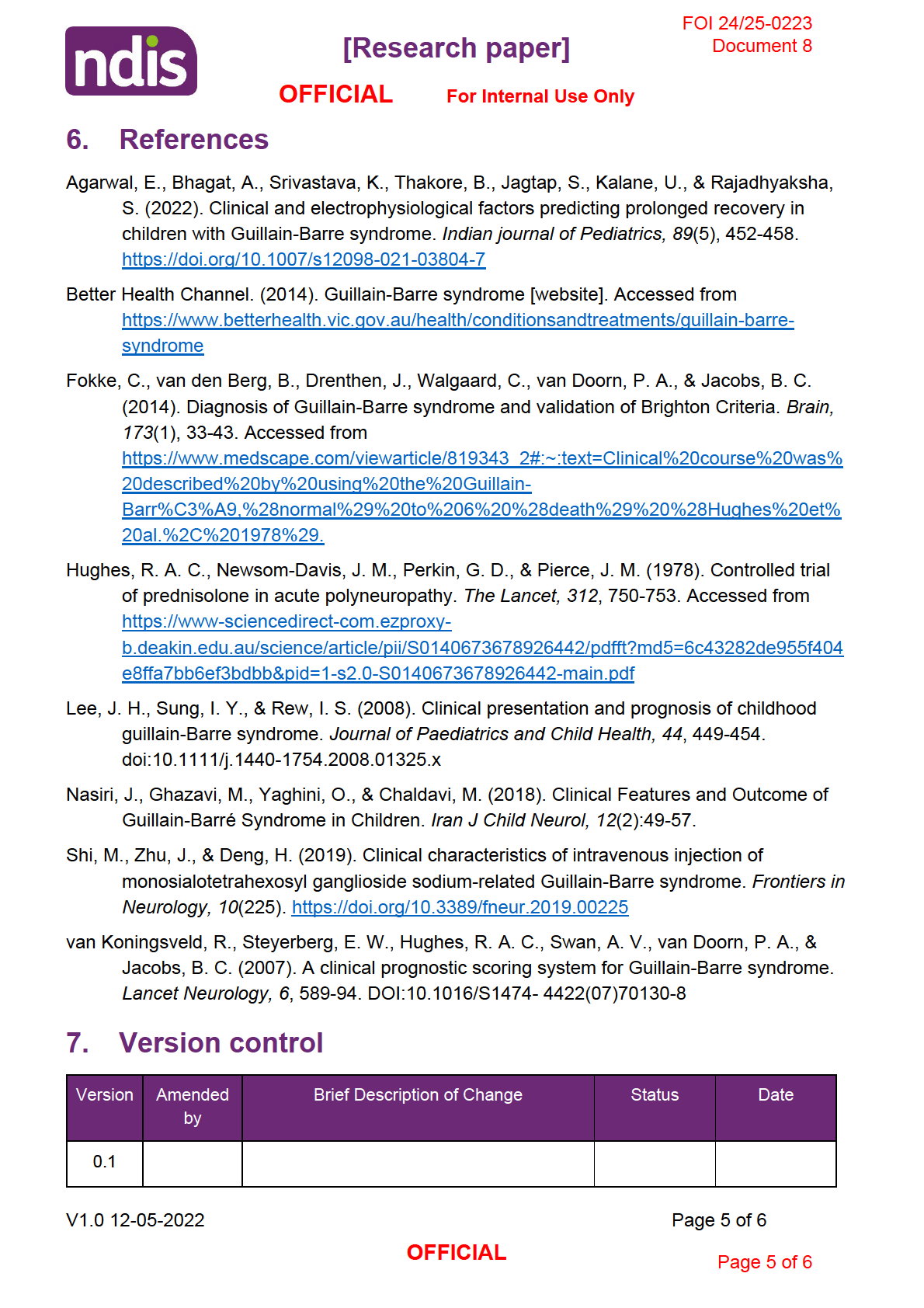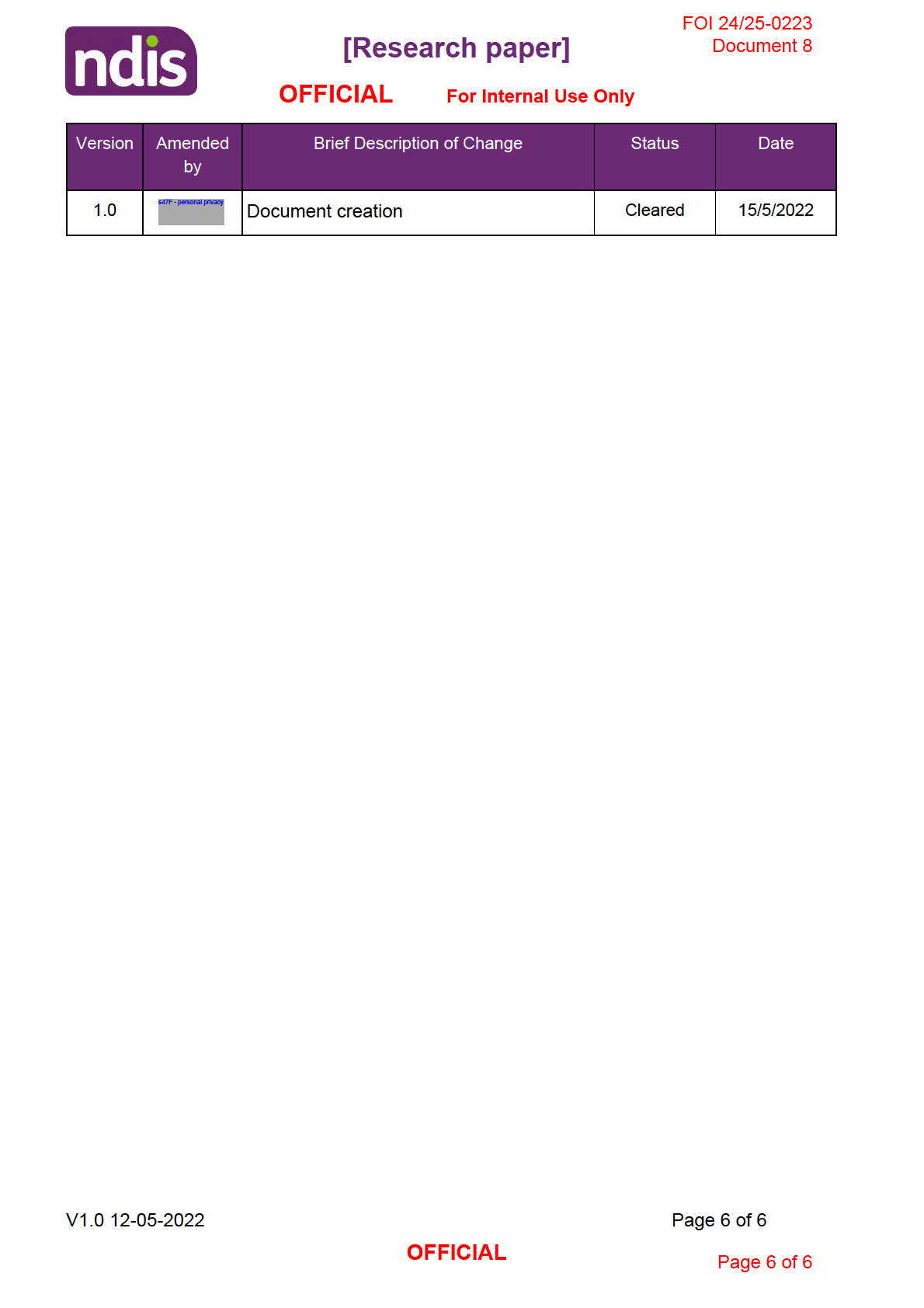
FOI 24/25-0223
[Research paper]
Document 8
OFFICIAL
For Internal Use Only
Guillain-Barre syndrome diagnosis in children
The content of this document is OFFICIAL.
Please note:
The research and literature reviews collated by our TAB Research Team are not to be shared
external to the Branch. These are for internal TAB use only and are intended to assist our
advisors with their reasonable and necessary decision-making. Delegates have access to a
wide variety of comprehensive guidance material. If Delegates require further information on
access or planning matters, they are to call the TAPS line for advice. The Research Team are
unable to ensure that the information listed below provides an accurate & up-to-date snapshot
of these matters
Research questions:
What are the clinical outcomes expected for children diagnosed with Guil ain-Barre syndrome?
How does the Guil ain-Barre disability score compare to the Hughes scale?
Date: 12/5/2022
Requestor: s47F - personal privacy
Endorsed by (EL1 or above): Researcher: Stephanie Ps47F - personal
privacy
Cleared by: Stephanie Ps47F - personal
privacy
1. Contents
Guillain-Barre syndrome diagnosis in children ........................................................................... 1
1.
Contents ....................................................................................................................... 1
2.
Summary ...................................................................................................................... 2
3.
Guillain-Barre Syndrome in children ............................................................................. 2
4.
Guillain-Barre Disability Score ...................................................................................... 3
5.
Hughes Functional Grading Scale ................................................................................ 4
6.
References ................................................................................................................... 5
7.
Version control .............................................................................................................. 5
V1.0 12-05-2022
Page 1 of 6
OFFICIAL
Page 1 of 6

FOI 24/25-0223
[Research paper]
Document 8
OFFICIAL
For Internal Use Only
2. Summary
This research is a supplement to RES212 Guil ain Barre Syndrome (completed 5/8/2021).
Guillain-Barre syndrome is more common in adults than children. While research in children is
limited, information sourced suggests that children are likely to have a better clinical outcome
after a diagnosis of Guil ain-Barre syndrome than adults. Two subtypes of Guil ain-Barre
syndrome have been discussed in the literature – AMAN and AIDP (defined below). There is
some evidence to suggest that diagnosis of subtype AMAN may lead to greater physical
impairment at 6- and 12-months post diagnosis, however similar clinical outcomes are
reported at 2 years post diagnosis.
The Guil ain-Barre Disability Score appears to be a method used by Hughes to grade
symptoms prior to the development of the Hughes Functional Grading Scale. These are
discussed below.
3. Guillain-Barre Syndrome in children
Literature regarding the prognosis for Guil ain-Barre syndrome for Australian children could not
be sourced. However, there are international studies exploring the clinical prognosis of
children who are diagnosed with Guil ain-Barre syndrome.
Guillain-Barre syndrome predominantly affects adults, however diagnosis in the paediatric
population is more common in children under 10 years old (Nasiri et al, 2018). More
specifical y, diagnosis most often involves children aged between 1 and 5 years and males are
affected more than females (Nasiri et al, 2018). Research suggests that children have a more
favourable clinical course and outcome compared to adults diagnosed with Guil ain-Barre
syndrome (Argarwal et al, 2022; Nasiri et al, 2018). Argarwal et al (2022) found that age of
presentation and gender did not influence the clinical outcome.
Common paediatric presentations have been identified as distal limb weakness, reduced
tendon reflex, pain and paraethesia (Lee et al, 2008; Nasiri et al, 2018). Dysarthria, facial
palsy, ophthalmoplegia and urinary problems have also been observed (Lee et al, 2008).
Two main subtypes have been described in the literature depending on the location of neural
inflammation: AMAN (acute motor axonal neuropathy) and AIDP (acute inflammatory
demyelinating polyradiculoneuropathy). The literature indicates that children diagnosed with
AMAN may have greater clinical symptoms evident as a worse Hughes score at nadir
compared to children diagnosed with AIDP subtype (Argarwal et al, 2022). Additional y,
children diagnosed with AMAN may have a slower recovery phase with poorer outcomes at 6-
and 12-months post-onset (Lee et al, 2008). However, Lee et al (2008) also cited research
from Japan where 35% of the cohort were diagnosed with AIDP and 48% with AMAN and both
groups had comparable favourable recoveries at 12 months post-onset.
V1.0 12-05-2022
Page 2 of 6
OFFICIAL
Page 2 of 6

FOI 24/25-0223
[Research paper]
Document 8
OFFICIAL
For Internal Use Only
Overall, the literature suggests that children diagnosed with Guil ain-Barre syndrome have
good functional status regardless of whether axons or myelin sheaths are affected (Argarwal et
al, 2022; Lee et al, 2008). Retrospective research by Nasiri et al (2018) compared international
research data of paediatric outcomes with their study population of Iranian children,
unfortunately they did not indicate the time period that had elapsed from onset to when the
clinical was outcome measured. In their study, 92% of children recovered fully and there was a
1.8% mortality rate – this was identified as being similar to research data from France, Tabriz
and India (Nasiri et al, 2018). Further, 5% reported incomplete recovery which was similar to
research data Nasiri et al (2018) obtained from India.
Information on the Better Health Channel website (2014) is not specific to children, but it
indicates that full recovery from Guil ain-Barre syndrome can be ‘two years or more’. Better
Health Channel advises that physical therapy is important to facilitate recovery and prevent
muscle contractures and associated deformities.
4. Guillain-Barre Disability Score
A 2014 study by Fokke et al suggests the Guil ain-Barre syndrome disability score, as
described in research by Hughes et al (1978), is a widely accepted scale of disability for
individuals with Guillain-Barre syndrome. The research by Hughes et al (1978) uses the score
for neurological assessment of enduring symptoms of Guil ain-Barre syndrome 1 year after
diagnosis. The ‘Guil ain-Barre Disability Score’ is a 6-point rating scale as follows (Hughes et
al, 1978):
0 = healthy
1 = minor signs or symptoms of neuropathy but capable of manual work
2 = able to walk without support of a stick but incapable of manual work
3 = able to walk with a stick, appliance, or support
4 = confined to bed or chairbound
5 = requiring assisted ventilation
6 = dead
A reference to the Guil ain-Barre Disability Scale was found in van Koningsveld et al (2007)
who aimed to develop a clinical scoring system for clinical prognosis and used the Guil ain-
Barre Disability score in their modelling. These researchers defined a ‘poor outcome’ as a
score of 3 or more at 6 months which corresponded to the inability to walk 10m independently.
A ‘fairly good outcome’ was considered a score of 2 or less at 6 months. Data was taken at 6
months as this was considered the time period where most of the recovery process would
have occurred (van Koningsveld et al, 2007).
Validity and reliability data for the Guil ain-Barre Disability Score could not be sourced.
V1.0 12-05-2022
Page 3 of 6
OFFICIAL
Page 3 of 6

FOI 24/25-0223
[Research paper]
Document 8
OFFICIAL
For Internal Use Only
5. Hughes Functional Grading Scale
The Hughes Functional Grading Scale provides a measure of disability and is used to rate
clinical performance (Shi et al, 2019). The scale is a 6-point rating scale and appears to be
based on the Guil ain-Barre Disability Score but has more specific criteria for ratings 2 and 3:
0 = normal
1 = slight clinical symptoms
2 = able to walk 5m or more without assistance but unable to run
3 = able to walk 5m with help
4 = bedridden or chairbound
5 = ventilator-assisted breathing
6 = death
V1.0 12-05-2022
Page 4 of 6
OFFICIAL
Page 4 of 6







